Carrickfergus Mar 21 After our breakfast, at the hotel, we decided that we still had questions about the Troubles and wanted to visit the Free Derry Museum in Bogside. So we checked out of the hotel, left our bags in the car and walked down the hill. 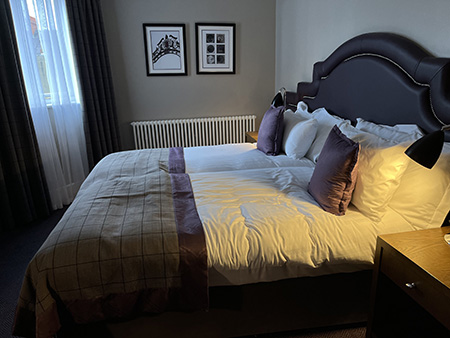
Our room in Bishop's Gate Hotel 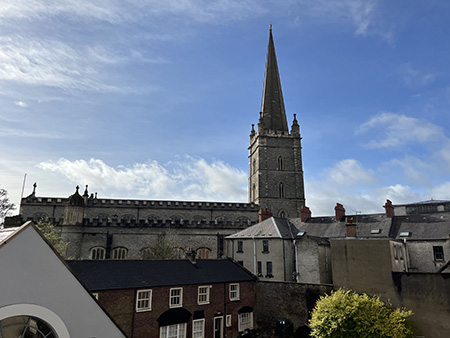
View of St. Columb Cathedral from our hotel room window - this was the first Protestant cathedral built in Europe after the Reformation The Free Derry Museum is an exhibit which explains the timeline of the events leading up to Bloody Sunday. There is a brief introduction, and then guests visit the exhibit on their own. The exhibits provide a context for the events, several artifacts from the times, and video and audio recordings of significant moments during the Troubles. But the most surprising thing for us was that our introduction to the museum was given by a 70-year-old volunteer, Jimmy Toye, himself a survivor of Bloody Sunday. 
We were grateful to meet Jimmy Toye and get a first-hand account of Bloody Sunday and the subsequent years of the Troubles We weren't the only museum guests to whom he was giving the orientation - there were three others besides us, but we were all Americans. There was a couple from Rhode Island about the same age as we and a young woman from New York. When we realized who we were talking to, we had lots of questions, and Jimmy answered all of them from his perspective. It was rather moving to hear his firsthand account. He lost friends on that day, and a man beside him was shot dead. He knew several of the persons killed and wounded because his family owned a general store in Bogside, and he often worked there. 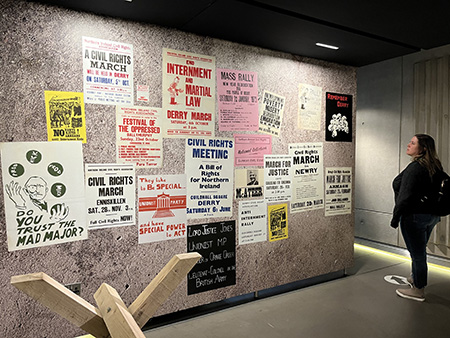
Exhibit in the Museum of Free Derry, which explains the events leading up to Bloody Sunday Jimmy personally gave testimony in the Saville investigation (a second investigation that was done from 2000 to 2010 because the first one, the "Widgery Whitewash" was a corrupt cover-up. For that investigation, done shortly after the events of Bloody Sunday in 1972, the investigators refused to take any testimony from the injured, and the British soldiers who gave their accounts did so anonymously and while in disguise. It came out later that even those accounts had been altered to suit the version that the government wished to be given.) 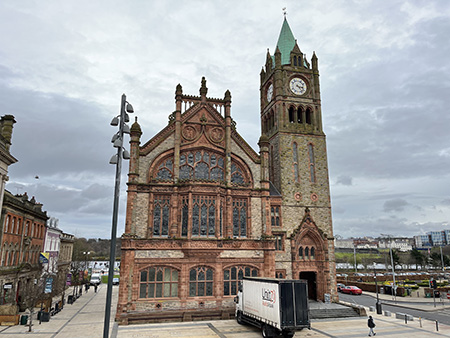
The Guildhall in Derry, where witnesses to Bloody Sunday gave testimony to the Saville investigation One of the exhibits in the museum is a display with plastic and rubber bullets. Jimmy showed us a couple of those, and they were much larger than I had imagined. The plastic bullet in particular was a dense and heavy piece not much smaller than an orange juice can. When it was first proposed for use, there was a suggestion that it be tested on animals such as sheep or pigs. It was later revealed via a freedom-of-information inquiry that the military upper brass decided that in lieu of any tests with the projectile, they would "just use it in Northern Ireland." 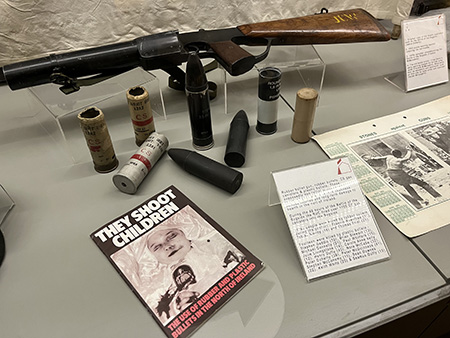
Exhibit in the Museum of Free Derry 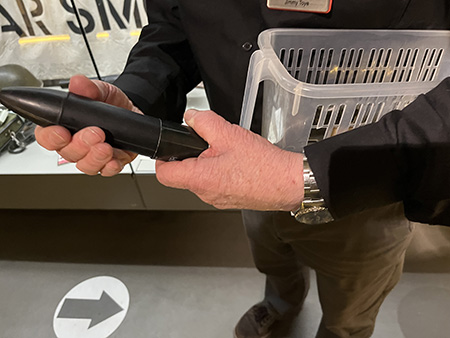
Jimmy shows us an example of the rubber bullets used by the British military in Northern Ireland 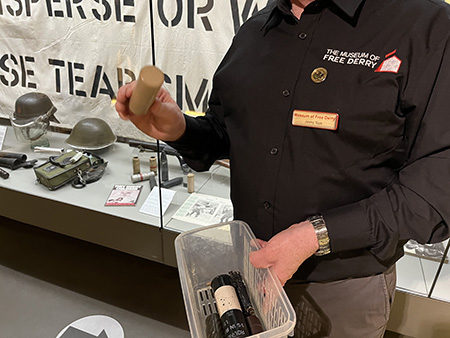
A plastic "bullet" Jimmy told us that he volunteers at the museum a couple of times a week, but it takes an emotional toll on him because talking about it all again brings back all the images he saw on that day. He described some of them for us. 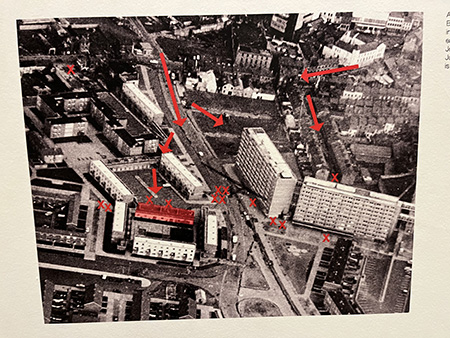
A photo in the Museum of Free Derry shows the route the British military took when advancing on the unarmed protestors 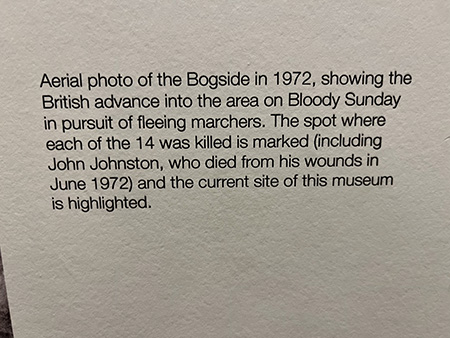
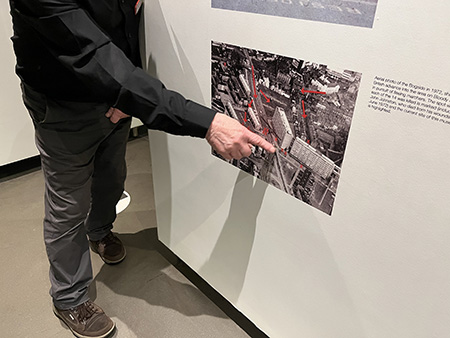
Jimmy points to his location on Bloody Sunday. He hid behind a utility box as the soldiers killed men around him. So now the museum visit became living history for us, and it was rather powerful. I had had serious doubts about the wisdom of visiting Derry and especially about visiting this museum, but I am so glad that we did. 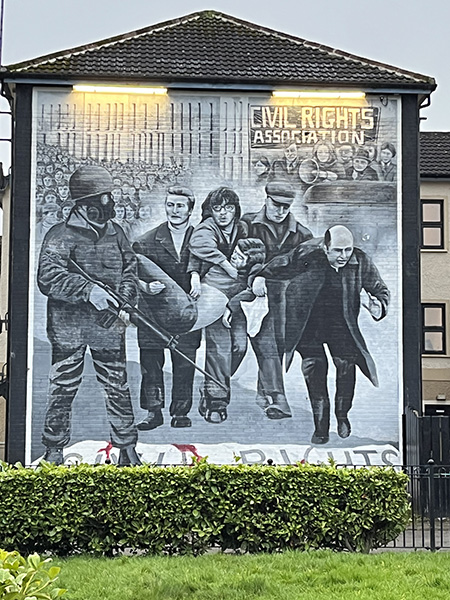
A mural in the Bogside reproduces a photo of Bloody Sunday. Father Edward Daly waves a white handkerchief as others carry a mortally wounded Jackie Duddy from the streets. 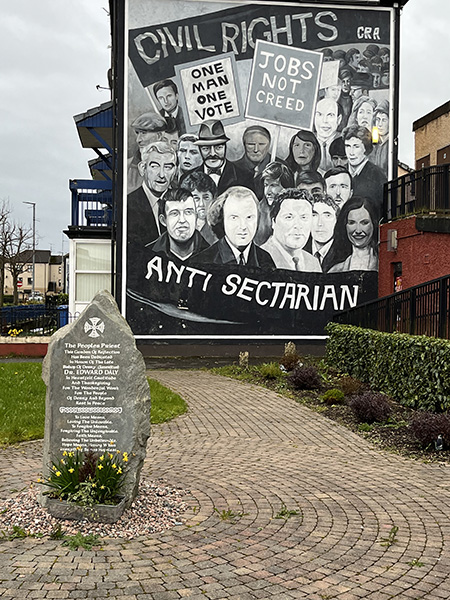
One of the murals in the Bogside 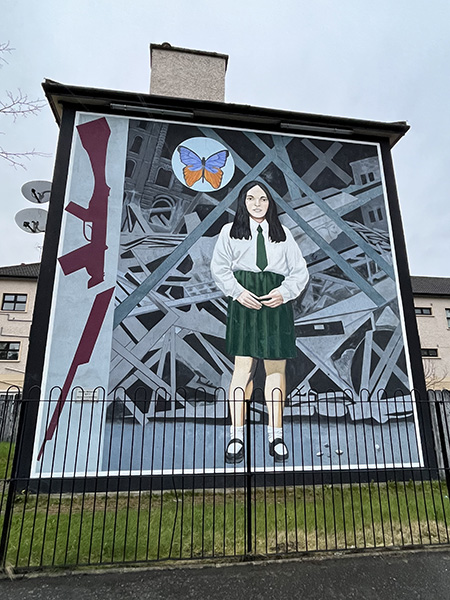
Annette McGavigan, one of the children killed during the Troubles 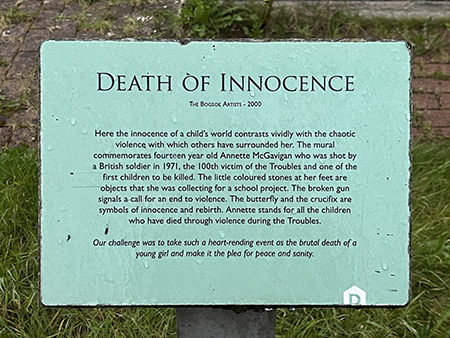
Explanation of the mural for Annette McGavigan As we left Bogside and were climbing pack up to our car on top of the hill in the walled city, we looked back to see a rainbow over Derry. 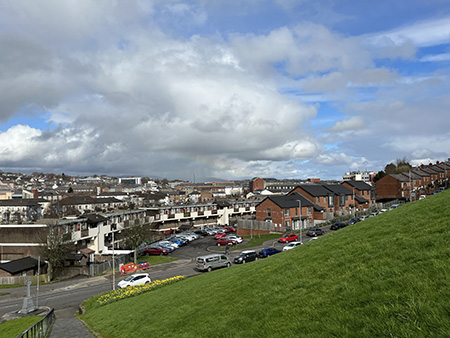
A faint but definite rainbow over the Bogside 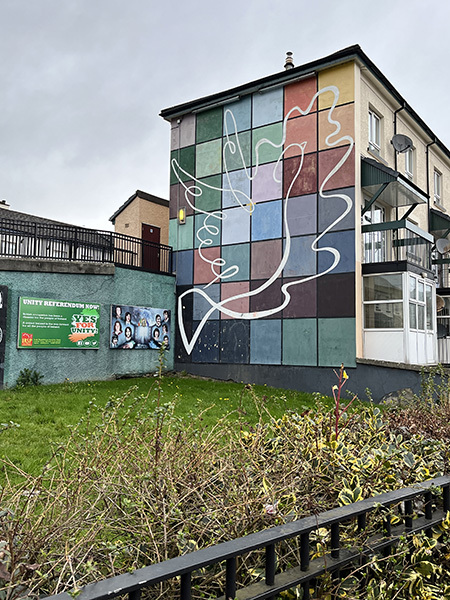
A mural designed by the children of Derry and Londonderry, expressing hope for the future. 
The people in the Bogside took inspiration from leaders who supported peaceful methods for advocating change. This mural depicts persons who were awarded a Nobel Peace Prize and whose ideals inspired civil rights leaders in Derry. Clockwise from top left - John Hume, Martin Luther King Jr., Nelson Mandela, Mother Teresa. 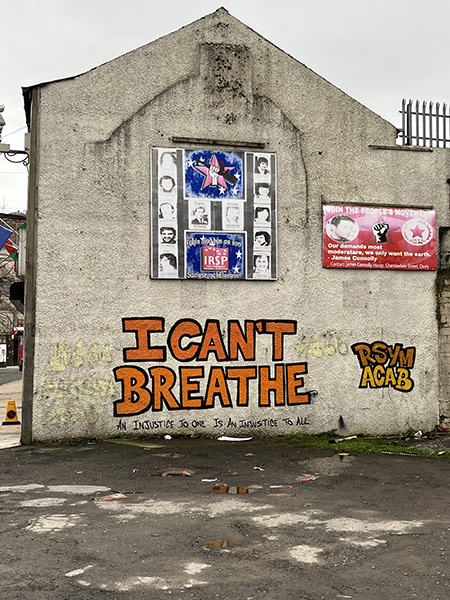
The people of the Bogside empathize with the struggles of others. For more information about the events of Bloody Sunday, visit the website of the Museum of Free Derry. The explanation and timeline of events under their menu "The Free Derry Story" and "Bloody Sunday" are especially helpful in understanding the events that occurred in the Bogside and elsewhere. When we got back to the parking lot, we had a parking ticket on our windshield, even though we understood that we had a valid parking permit until 2 pm that day. I think perhaps we misunderstood the time limits and/or the parking app that I downloaded and used, so in the near future we will need to deal with the parking fine or just never rent a car in Ireland again. (At this point, I think Steve would be perfectly okay with the latter.) From Derry, we drove north, and it wasn't long before we could see the coast. We had enjoyed partly sunny skies all morning, but the sky was beginning to become more overcast. Our goal was to visit the Giant's Causeway, a geologic formation along the northern coast of Ireland that has fascinated me for several years. Because it's so far up here - only 12 miles from Scotland across the North Atlantic - the Giant's Causeway just never seemed to get on the itinerary for earlier trips I had made, and I was determined to see it on this trip. It was really worth it. I just enjoyed seeing the cliffs, the funny-shaped rocks and the crashing sea. And we had an amusing guide, too. She told us several different legends about the giant Finn McCool and how he had created this place, all the while pointing out rock formations that are "evidence" of the story's veracity. We climbed around the rocks, took photos, watched the waves crashing on the rocks, watched the seal (Sammy) playing offshore, and survived the whole experience without getting our feet muddy or breaking our ankles. All in all, a very successful visit. 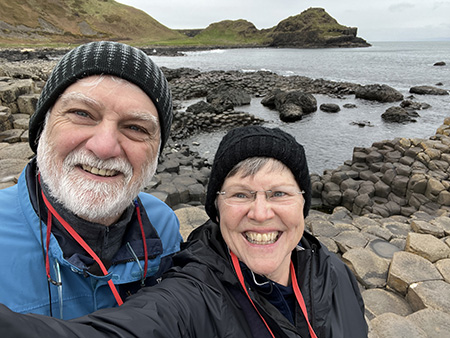
At the Giant's Causeway on the northern coast 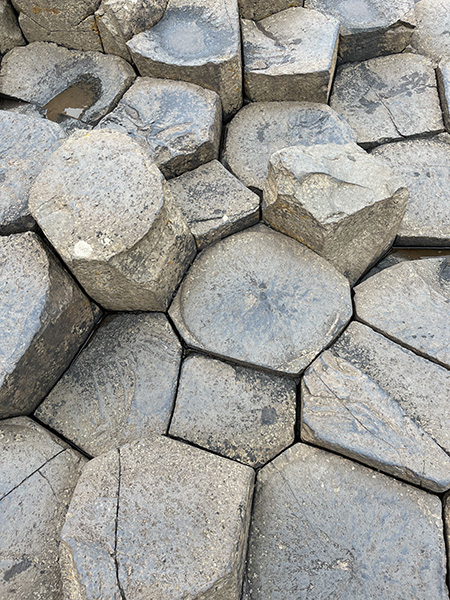
The Giant's Causeway 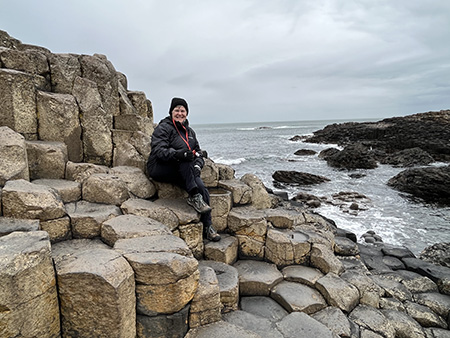
The Giant's Causeway 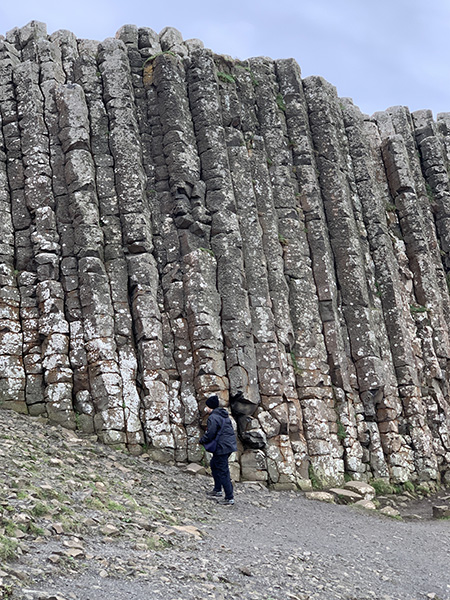
At the Giant's Causeway After our visit on the Causeway, we paused at the visitors' center long enough to have a cup of tea and a cookie (they were out of scones), and as we piled back in the car, it started raining. We had about an hour's drive to our hotel in Carrickfergus, but we wanted to make a brief stop at Dark Hedges, just one of those really touristy things that is a picturesque alleyway lined with trees. It has been made famous by "The Game of Thrones." Neither of us has seen a single episode of that series, but we had seen photos of the Dark Hedges and it looked cool. So we make the obligatory stop, took a couple of photos (in the rain) and moved on. It was near dusk, and with the heavy cloud cover making the driving less pleasant that usual (I mean, if you think "pleasant" includes threading the needle on a narrow lane with about 4 inches to spare on either side of your car as you choose between a rock wall and the semi-truck in the other lane.) We just wanted to get off the road before dark. 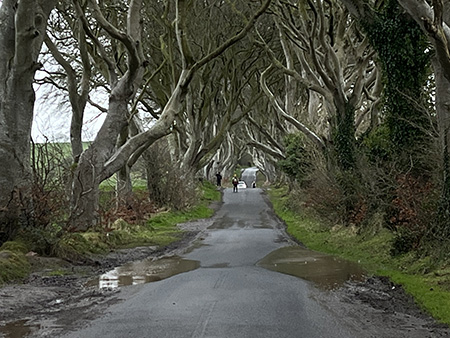
The Dark Hedges We just made it, arriving in Carrickfergus at twilight and in a thickening fog for the last five miles. We checked into the hotel - the Dobbins Inn - got their advice about the best place to park the car, and went out again to move the car down the street where we won't have to get out there by 9 am to move it to avoid a ticket. We had a yummy dinner in the hotel pub and headed up to bed. 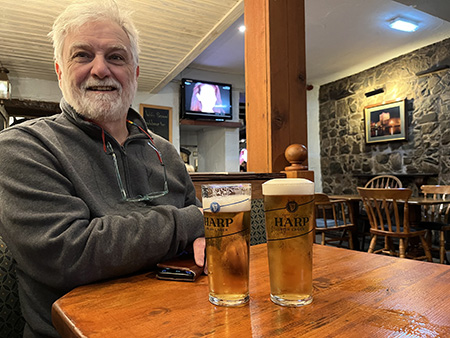
In the pub at the Dobbins Inn. This building has been on this site since at least 1530. Tomorrow: we drive south to Carlingford, see the Mountains of Mourne and meet a cousin. Next: Carlingford |
| Other stuff |
|
back to the top |